The Complete Fall Spices Guide: 10 Autumn Spices for Cooking

Think your fall cooking tastes flat? This fall spices guide will fix that. The secret to restaurant-quality autumn dishes isn’t fancy techniques – it’s understanding how autumn spices for cooking work their magic at specific temperatures and in the right combinations.
When you smell cinnamon baking at 350°F, you’re experiencing volatile compounds being released. That’s not just kitchen poetry – it’s science. We can use them to make our fall spices sing in everything from pumpkin pie to savory stews.
Key Takeaways: Your Fall Spice Arsenal
Here’s what actually works in home kitchens for creating those cozy seasonal ingredient flavors:
Sweet Fall Spices:
- Cinnamon: 1-2 teaspoons per batch, blooms best at 325-350°F in baked goods
- Nutmeg: Start with 1/4 teaspoon for pumpkin pie spice blends (it’s potent!)
- Ginger: 1 tablespoon fresh = 1 teaspoon ground, perfect for apple cider and recipes
- Cloves: Use whole for slow-cooking stews, ground for quick applications
- Allspice: Single spice that tastes like cinnamon, cloves, nutmeg, and pepper combined
Savory Fall Spices:
- Cardamom: Crush pods fresh, toast at medium heat for citrus complexity
- Smoked paprika: Essential for savory dishes and roasted vegetables at 425°F
- Sage: 1 teaspoon fresh per pound of protein, fry in butter for crispy finish
- Rosemary: Add during last 15 minutes of roasting to prevent burning
- Cumin: Toast whole seeds first, perfect for earthy global flavors
What Are Autumn Spices?
Autumn spices are the warming spices that define fall cooking – think cinnamon, nutmeg, cloves, ginger, and allspice. These ground spices and whole spices create the flavors we associate with cozy fall season cooking, from pumpkin pie to hearty soups.
Sweet Fall Spices Guide: Building Your Pumpkin Pie Spice Foundation
Cinnamon: Your Fall Flavor Foundation
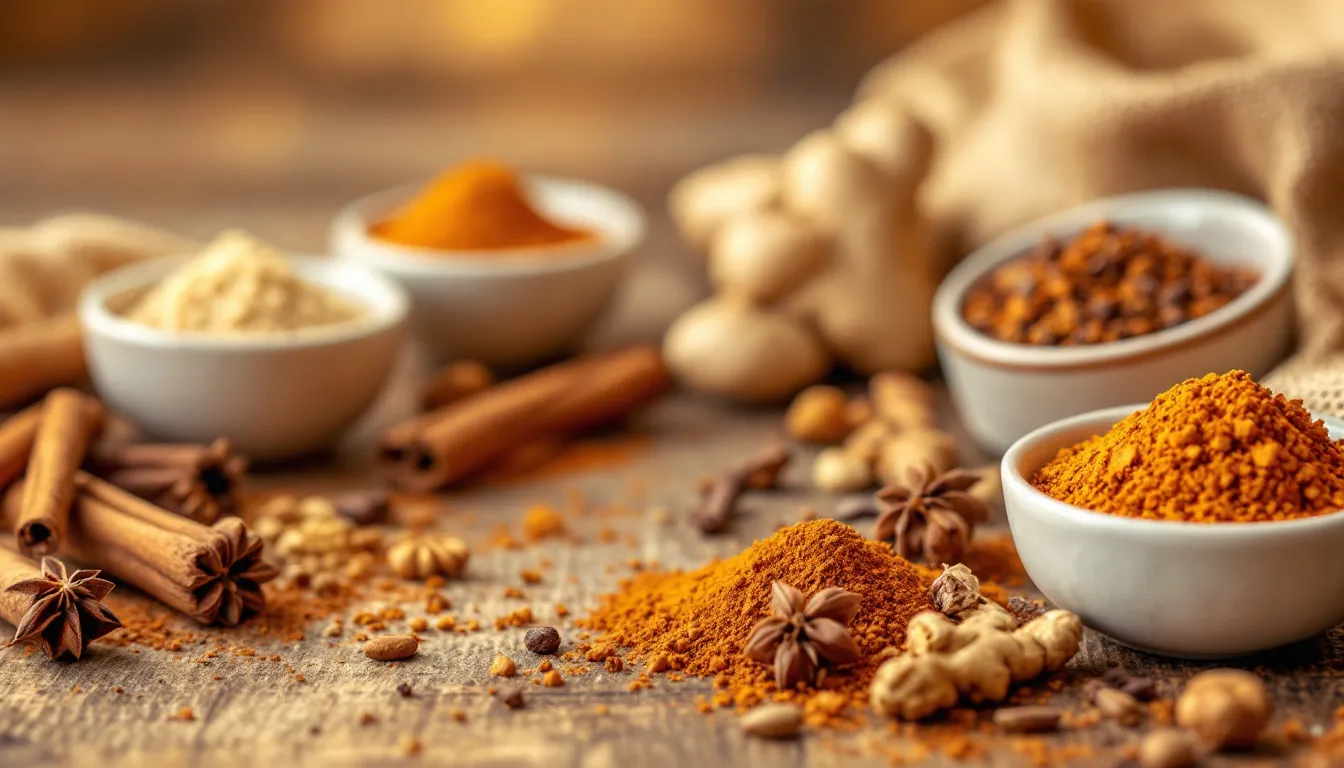
What makes cinnamon taste like autumn? It’s all about cinnamaldehyde – the compound that gives cinnamon its warmth. But here’s what most home cooks don’t know: Ceylon cinnamon tastes sweeter and more complex than the common Cassia variety.
For fall spices essentials, cinnamon is your MVP in both sweet and savory applications. Heat it gently in a dry pan for 30-60 seconds before adding to recipes – this technique releases aromatic oils that make your kitchen smell like a cozy café.
Pro hack: I used to dump cinnamon into cold batters and wonder why the flavor was meh. Now I bloom it in melted brown sugar or butter first (when I can). The fat carries flavor better than anything else.
Try this tonight: Add 1 teaspoon of cinnamon to roasted vegetables at 425°F during the last 10 minutes. Watch how it caramelizes with sweet potatoes and creates depth you never knew was missing.
Cinnamon works perfectly in:
- Apple pie and apple cider
- Pumpkin pie and pumpkin soups
- Baked goods like cinnamon rolls
- Savory dishes with chicken and pork
Nutmeg: The Pumpkin Pie Spice Game-Changer
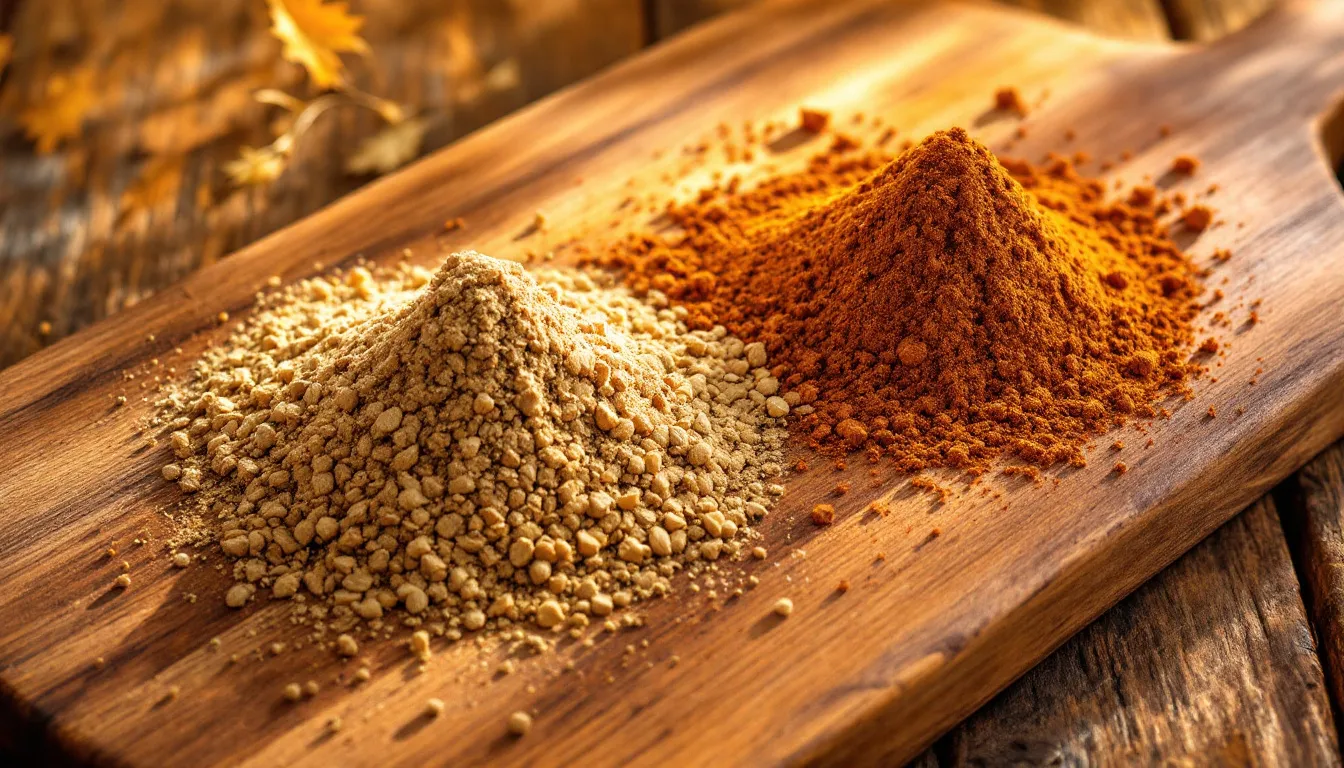
Nutmeg is the secret weapon in every pumpkin pie spice blend. A little goes a long way – we’re talking 1/4 teaspoon for most recipes, because this spice can overpower faster than you’d think.
The science behind nutmeg’s warmth? It contains myristicin, which gives that slightly sweet, slightly bitter complexity. Fresh-grated nutmeg has about 40% more volatile oils than pre-ground – that’s why your grandmother always grated it herself.
Perfect nutmeg applications:
- Pumpkin pie and pumpkin soups
- Cream sauces with vegetables
- Sweet potatoes and squash dishes
- Fall baked goods and custards
Nutmeg secret weapon: You can add just a bit of nutmeg to white sauces to create depth and flavor.
Ginger: Your Autumn Energy Boost
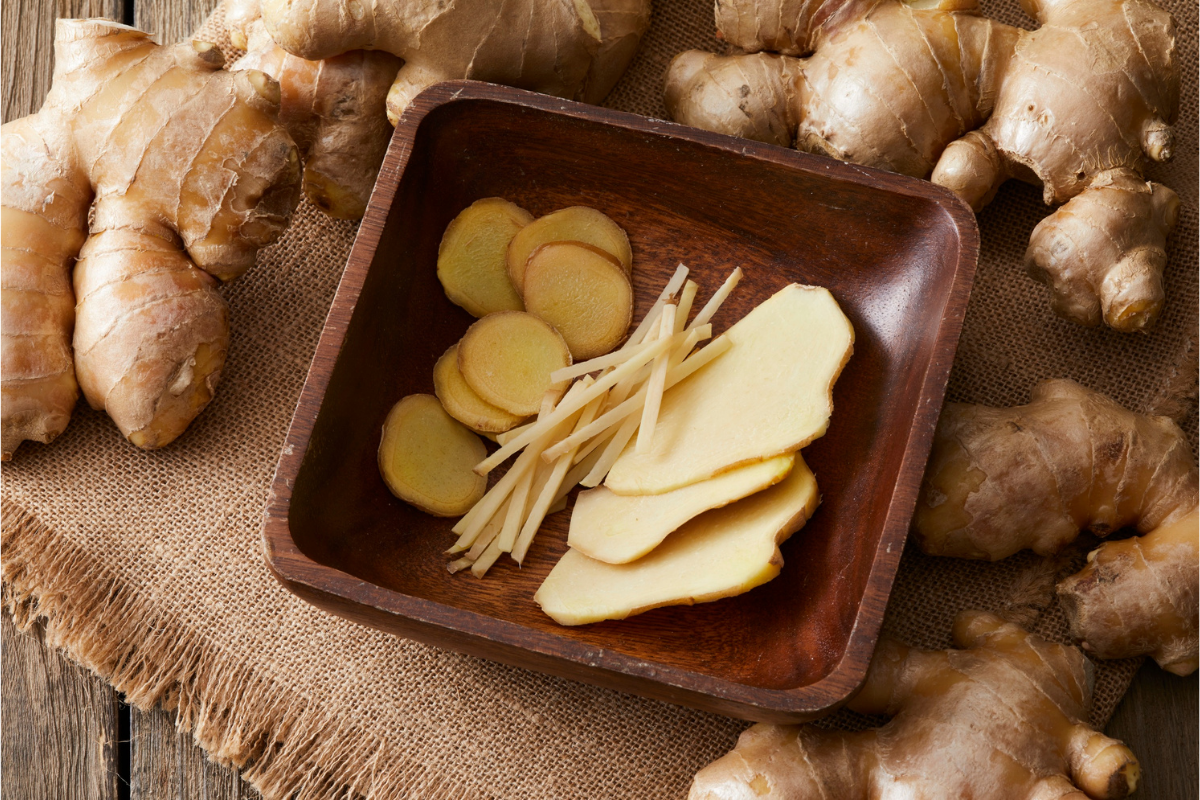
Ginger brings heat and brightness that cuts through rich autumn dishes. This rhizome brings sharp, clean heat that tastes great in both sweet and savory applications.
Fresh vs. ground ginger isn’t just about convenience – they’re practically different ingredients. Fresh ginger has compounds that create sharp heat. Ground ginger is mellower, earthier, perfect for baked goods and apple cider.
Temperature matters with ginger: Add fresh ginger early in cooking to mellow it out, or at the end for punch. Ground ginger can handle longer cooking times in stews and soups without losing character.
Ginger shines in:
- Apple cider and tea blends
- Baked goods like gingerbread
- Savory dishes with vegetables
- Fall soups and stews
Cloves: The Intensity Specialist
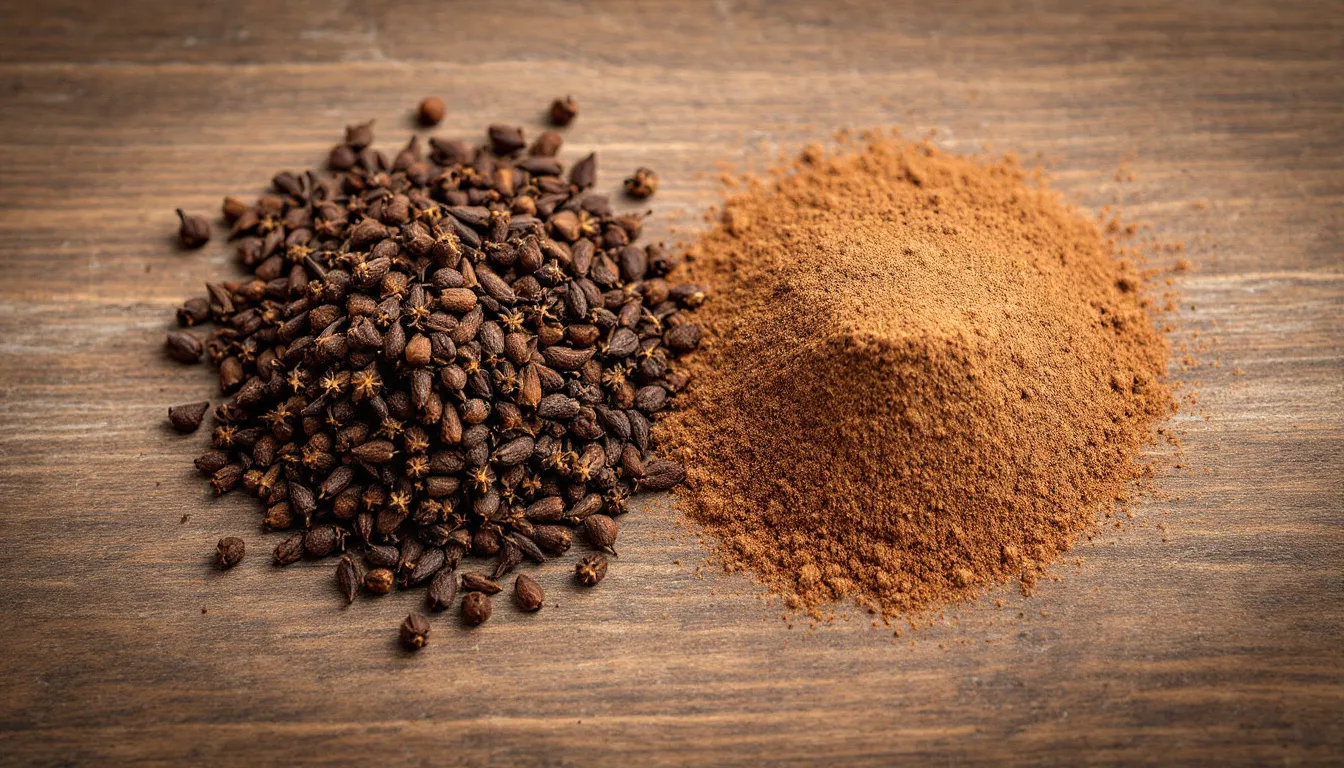
Cloves pack serious punch – eugenol gives them that distinctive warm-meets-medicinal flavor. Use whole cloves for slow stews (remove before serving), ground for quick applications in baked goods.
Cloves are one of the key ingredients in pumpkin pie spice blends and pair beautifully with apples, pumpkin, and sweet dishes. Start with just a pinch – cloves can overwhelm your taste buds quickly.
Perfect clove pairings:
- Pumpkin pie and apple pie
- Apple cider and tea
- Stews with pork and lamb
- Fall baked goods
Allspice: The Ultimate Fall Blend
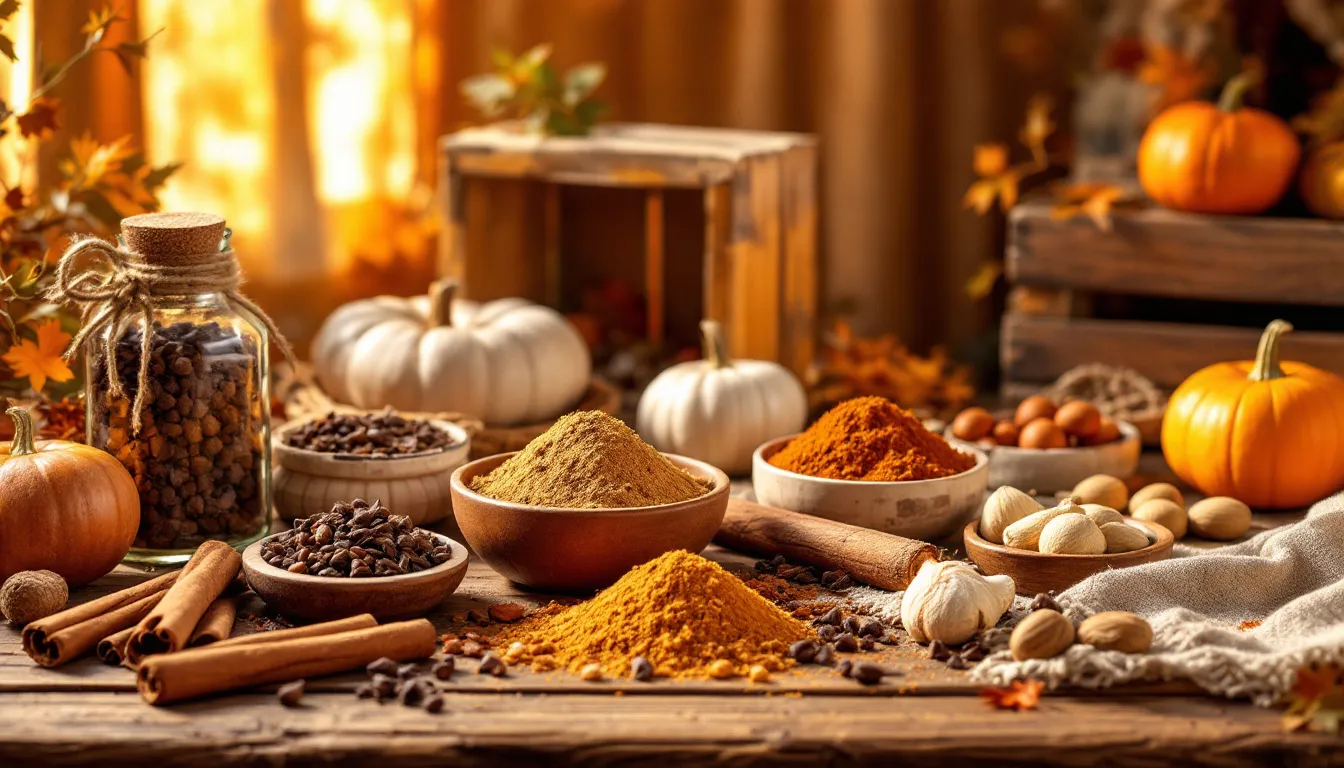
What are the five spices in allspice? Actually, allspice isn’t a blend – it’s a single spice that tastes like cinnamon, cloves, nutmeg, and pepper combined. This makes allspice incredibly versatile for fall cooking.
Allspice complements food ranging from carrots and sweet potatoes to apples and pork. Use it in pumpkin pie spice blends, savory dishes, and baked goods year round.
Allspice enhances:
- Apple pie and pumpkin pie
- Stews with pork and lamb
- Roasted vegetables and squash
- Fall recipes with seasonal ingredients
Savory Autumn Spices: Adding Depth to Fall Dishes
Cardamom: The Sophisticated Citrus Spice

Cardamom brings a unique citrusy, minty flavor that prevents autumn flavors from getting too heavy. This spice is your secret weapon for creating complex fall dishes that surprise your taste buds.
The science behind cardamom’s magic? It contains compounds like eucalyptol and alpha-terpineol that give it that distinctive citrus brightness. Crush whole cardamom pods right before using – those little black seeds inside lose 50% of their flavor within 6 months once ground.
Pro tip: Toast cardamom pods in a dry pan at medium heat for 2-3 minutes before crushing. This releases oils that make your citrus vinaigrette and tea blends incredibly aromatic.
Cardamom works beautifully in:
- Citrus vinaigrette for fall salads
- Rice dishes and grains like quinoa
- Tea blends with ginger and cloves
- Sweet dishes where you want complexity
Temperature matters: Add cardamom at the end of cooking for savory dishes, or bloom it early in sweet applications. Its citrus notes can turn bitter if overheated above 300°F.
Smoked Paprika: Your Savory Secret Weapon
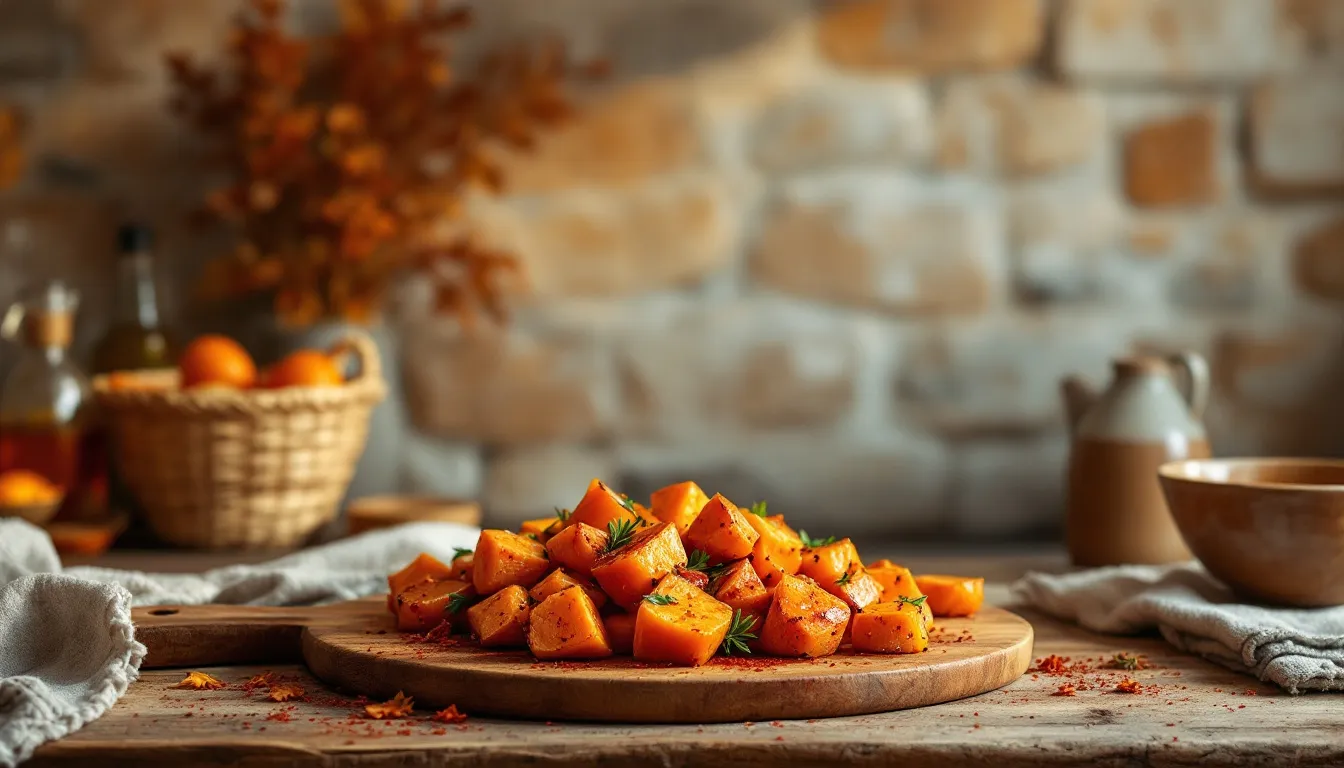
When seasonal ingredients include heartier vegetables and meats, smoked paprika adds depth without heat. This Spanish spice gives you that smoky flavor without actual fire.
Smoked paprika transforms simple roasted vegetables into restaurant-quality dishes. Sprinkle it on sweet potatoes, carrots, or squash before roasting at 425°F for incredible flavor.
Smoked paprika works magic with:
- Roasted vegetables like sweet potatoes
- Chicken and turkey rubs
- Savory dishes with beans and grains
- Fall soups and stews
Sage: Earthy Sophistication for Savory Fall Dishes
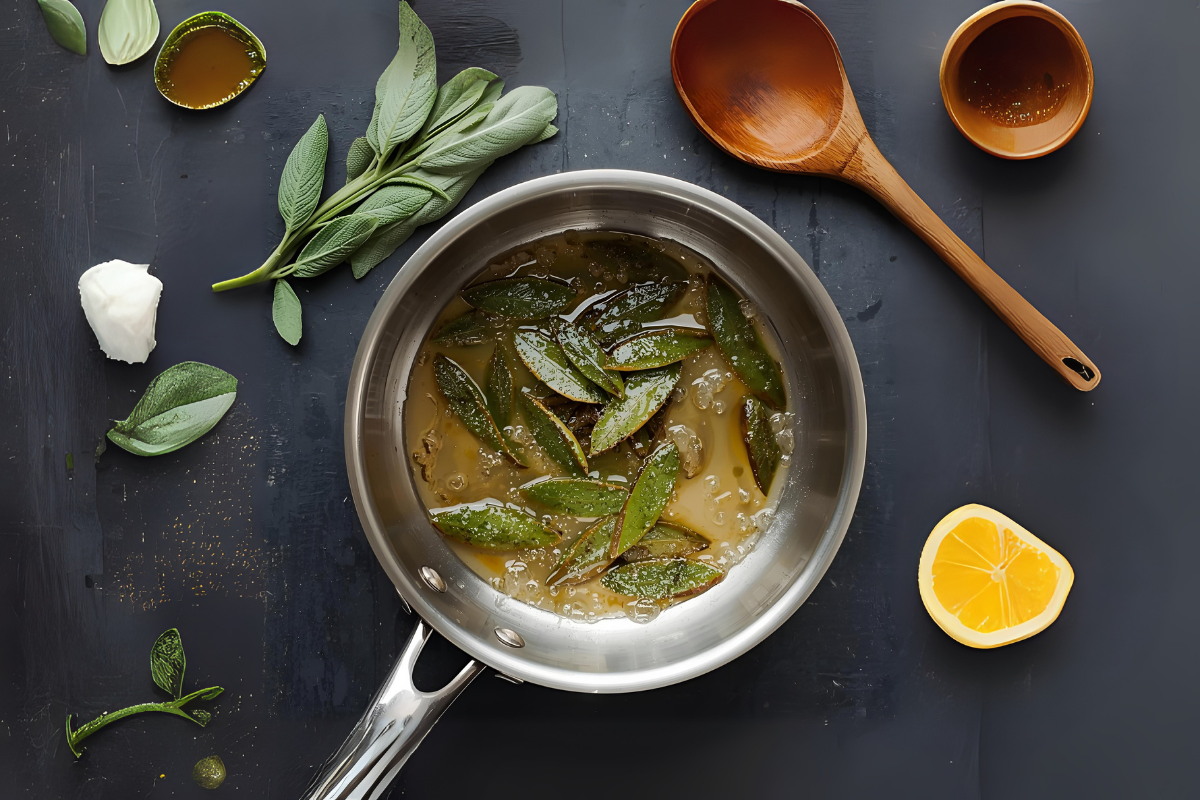
Sage brings earthy sophistication that transforms simple ingredients into restaurant-quality meals. This herb contains compounds like thujone and camphor that create its distinctive flavor – earthy, slightly bitter, with hints of citrus.
Here’s what separates good sage usage from great: fresh sage leaves fried in butter at 325°F for 30-60 seconds become crispy and nutty, perfect for finishing dishes. Dried sage works better in longer-cooking applications like stews and braises.
Sage pairs perfectly with:
- Pork and turkey – especially for thanksgiving dinner (and pork chops)
- Stuffed vegetables like sweet potatoes and squash
- Beans and grains in hearty fall soups
- Cream sauces for pasta and roasted vegetables
Sage tip: It is easy to use too much sage and overpower everything. Start with 1 teaspoon fresh (or 1/2 teaspoon dried) per pound of protein. You can always add more.
Try this tonight: Toss sweet potatoes with olive oil, salt, pepper, and fresh sage before roasting at 425°F. The sage crisps up and adds earthy depth that tastes great.
Rosemary: Pine-Fresh Flavor for Fall Roasts
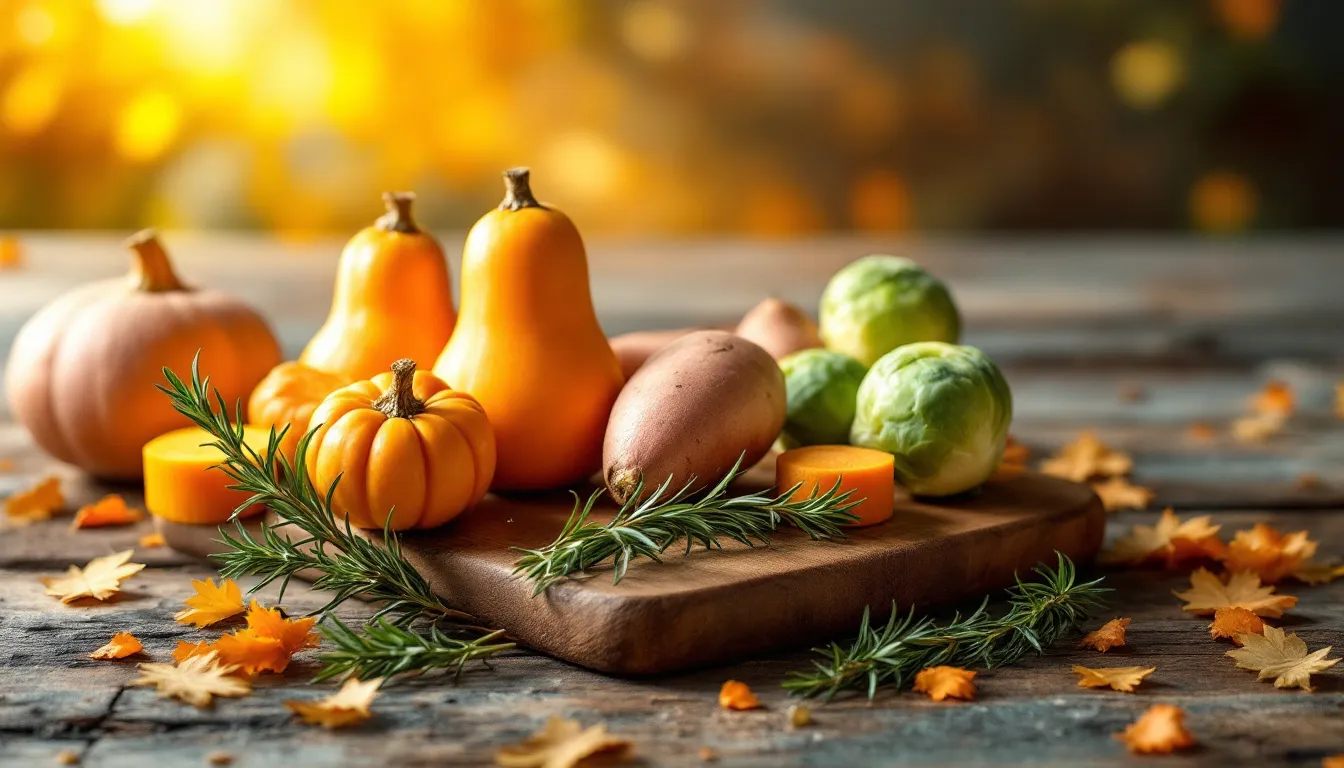
Rosemary’s piney, almost citrus-like flavor adds freshness that cuts through rich fall dishes. This herb contains compounds like rosmarinic acid and camphor that give it both flavor and natural preservative qualities.
The key to rosemary success? Strip the leaves from woody stems and chop them finely – those needle-like leaves can be tough if left whole. For roasted vegetables and meats, add rosemary during the last 15-20 minutes to prevent burning.
Rosemary excels with:
- Roasted vegetables like carrots and sweet potatoes
- Chicken, lamb, and turkey roasts
- Pumpkin and squash soups
- Rice dishes and grain bowls
Temperature science: Rosemary can handle high heat (up to 425°F) without losing flavor, making it perfect for oven roasting. Lower temperatures (325°F) work better for infusing oils and sauces.
Kitchen tip: Make rosemary oil by gently heating olive oil to 200°F and steeping fresh rosemary for 30 minutes. Sprinkle this over roasted vegetables or use as a finishing oil.
Cumin: Earthy Warmth for Global Fall Flavors
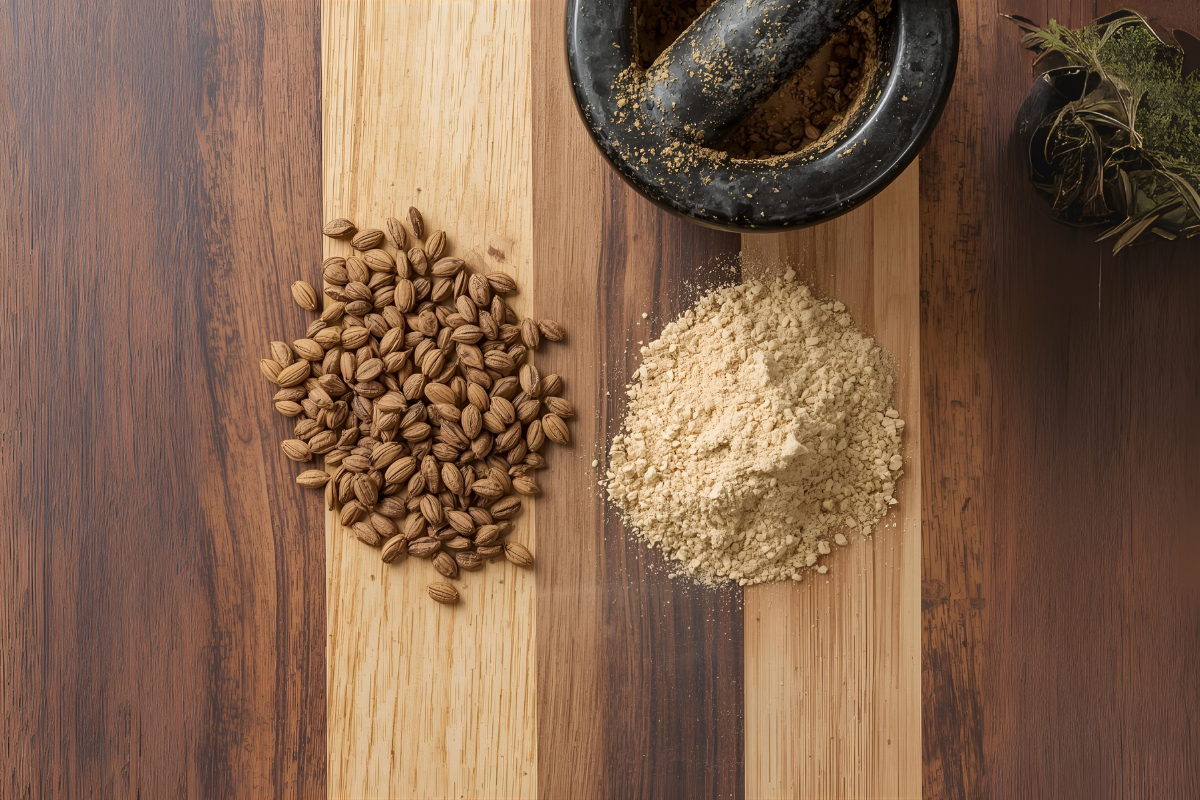
Cumin’s earthy, slightly sweet flavor adds depth that transforms simple vegetables and grains into complex dishes. This spice contains compounds like cuminaldehyde that intensify when heated, making toasting essential.
Here’s the cumin game-changer: toast whole cumin seeds in a dry pan for 2-3 minutes until fragrant, then grind fresh. This technique releases oils that pre-ground cumin simply can’t match.
Cumin brings global fall flavors to:
- Beans and grains like quinoa and rice
- Roasted vegetables with smoky depth
- Stews and soups with earthy richness
- Savory dishes that need warming spices
The science of cumin and heat: Heating cumin above 300°F develops its earthy flavor, but don’t go over 400°F or it becomes bitter. Perfect for oven roasting at 375-400°F with sweet potatoes and carrots.
Global inspiration: Cumin paired with smoked paprika creates Spanish-inspired flavors. Combine it with cardamom and ginger for Middle Eastern taste. Mix with cloves and cinnamon for warming fall spice blends.
Fall Season Recipes That Celebrate Seasonal Ingredients
What ingredients are in season in fall? Pumpkin, sweet potatoes, apples, squash, carrots – these seasonal ingredients pair perfectly with fall spices.
Classic Fall Flavors Blend:
- 3 tablespoons cinnamon
- 2 teaspoons ginger
- 2 teaspoons nutmeg
- 1 teaspoon allspice
- 1 teaspoon cloves
Savory Fall Blend:
- 2 tablespoons smoked paprika
- 1 tablespoon cumin
- 2 teaspoons sage
- 1 teaspoon rosemary
- 1/2 teaspoon cardamom
Perfect Fall Dishes for Your Spice Collection
What are classic fall ingredients? Start with pumpkin, sweet potatoes, and apples, then build flavor with the right spice combinations.
Thanksgiving Dinner Essentials:
Roast your turkey with sage and rosemary. Serve sweet potatoes with cinnamon and nutmeg. Create stuffed vegetables with allspice and herbs. Fill your bowl with delicious fall flavors.
Pumpkin Perfection:
Pumpkin pie needs pumpkin pie spice – that blend of cinnamon, nutmeg, ginger, cloves, and allspice. But don’t stop there. Toss pumpkin with smoked paprika for savory dishes, or sprinkle pumpkin pie spice on roasted vegetables.
Sweet Potato Success:
Sweet potatoes taste great with warming spices. Roast them with cinnamon and a touch of heat from paprika. Serve them hot from the oven with a sprinkle of salt.
Global Fall Flavors
What are festive spices? Different cultures celebrate fall with unique spice combinations:
- Cumin and cardamom in Middle Eastern dishes
- Ginger and cloves in Asian tea blends
- Smoked paprika in Spanish rice dishes
- Allspice in Caribbean beans and grains
Quinoa Fall Bowl:
Cook quinoa with fall spices, toss with roasted vegetables, and serve hot. Add tofu or chicken, sprinkle with herbs, and you have a delicious meal filled with seasonal flavor.
Storage and Pantry Tips
Keep your spice pantry stocked year round:
- Store whole spices in airtight containers (they last 2-3 years vs. 1 year for ground spices)
- Toast spices in a dry pan for 30-60 seconds to awaken oils
- Taste as you go – autumn spices can overpower quickly
- Mix spices with fats (butter, oil) to distribute flavor evenly
What Are the Trending Ingredients for Fall?

This season, food trends include:
- Pumpkin in savory dishes, not just sweet
- Sweet potatoes in soups and stews
- Swiss chard and hearty vegetables
- Beans and grains with warming spices
How to Eat Seasonally in Fall
What food is in season in October? Focus on apples, pumpkin, sweet potatoes, squash, and carrots. Use fall spices to enhance these seasonal ingredients in delicious recipes.
Celebrate the season by incorporating fall flavors into your daily meals. Whether you’re making apple pie or savory stews, the right spices transform simple ingredients into delicious food.
The Bottom Line: What Is the Most Popular Fall Spice?
While cinnamon reigns supreme, the best fall cooking uses a combination of spices. Fall flavors and spices work together to create the warming, comforting taste we crave during the fall season.
Your fall cooking doesn’t need to be complicated to be extraordinary. Start with quality spices, understand how heat affects flavor, and let seasonal ingredients inspire your recipes. That’s how you build confidence with autumn cooking in your kitchen.
What flavor is associated with fall? It’s not just one – it’s the harmony of warming spices that make food taste like autumn. From pumpkin pie to savory stews, these spices bring inspiration and delicious flavor to every meal.
Frequently Asked Questions
What are the five spices in allspice?
Allspice actually isn’t a blend of spices; it’s a single spice that tastes like a mix of pepper, cinnamon, cloves, and nutmeg. So when you use allspice, you’re getting warm, complex flavor all in one!
What are some popular dishes that use cinnamon?
Cinnamon is a star ingredient in delicious baked goods like cinnamon rolls, apple pie, and spiced cakes. It adds warmth to drinks like apple cider and spiced tea. You really can’t go wrong with a sprinkle of cinnamon!
How can I use nutmeg in savory dishes?
Nutmeg can elevate your savory dishes! Sprinkle it into pumpkin soup, roasted vegetables, or meat marinades to bring warm, nutty flavor to your meals.
What are the health benefits of ginger?
Ginger is great for reducing inflammation and improving digestion. Plus, it adds a delightful kick to your meals!
What spices are in season for fall?
Fall spices include cinnamon, nutmeg, ginger, cloves, allspice, smoked paprika, and cardamom. These spices pair perfectly with seasonal ingredients like pumpkin, sweet potatoes, and apples.
What are classic fall flavors?
Classic fall flavors combine warming spices like cinnamon, nutmeg, and cloves with seasonal ingredients like pumpkin, apples, and sweet potatoes. These create the cozy, comforting taste we associate with autumn.
What are autumn spices?
Autumn spices are warming spices that define fall cooking – cinnamon, nutmeg, ginger, cloves, allspice, and smoked paprika. These spices create the flavors we celebrate during the fall season.
